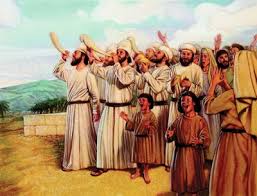The Revival of Temple Worship
Ezra 3: 1-13
During the ministry of Zerubbabel (to see link click Ag – The First Return).
Compiled by the Chronicler from the Ezra memoirs
(see Ac – Ezra-Nehemiah from a Jewish Perspective: The Ezra Memoirs).

Chapter 3 tells the story of the beginnings of the religious institutions at Jerusalem after the Babylonian captivity (see the commentary on Jeremiah Gu – Seventy Years of Imperial Babylonian Rule). It deals with the construction of the bronze altar, the worship services and offerings conducted upon that altar, laying the foundation for the Temple, the preparation for its construction, and the celebration of the people to the sight of it.
Prior to the exile, life in the southern kingdom of Judah centered in the Temple at Yerushalayim. This was a holy place of sacrifice, prayer, and singing. Although we lack detailed knowledge about the various rituals of Temple worship, we learn something of the character of this worship through the Psalms. The piety reflected in the ancient poetry, nourished in the context of animal sacrifices, offerings, and festive gatherings, has an enduring appeal to all believers. The God of the Psalms is the gracious One who accepts us as we are, who loves us and remains with us when those closest to us leave. The God of the Psalms is Immanuel – God with us (see the commentary on Isaiah Cb – The LORD Himself Will Give You A Sign).
This loving, saving God, who causes the heart of the psalmist to rejoice, is present in the Temple. His Sh’khinah glory and His Name are there (First Kings 8:11 and 29). We yearn for the Temple because in this sacred place we meet YHVH in the most holy place (see the commentary on Exodus Fs – The Mercy Seat in the Most Holy Place: Christ at the Throne of Grace). How lovely are Your tabernacles, ADONAI-Tzva’ot! My soul yearns, even faints, for the courts of ADONAI. My heart and my flesh sing for joy to the living God. ADONAI, I love the House where You live, the place where Your Sh’khinah glory dwells (Psalm 84:1-3 and Psalm 26:8).
The older Jews in exile remembered the Temple and Jerusalem with pain and deep love (Psalm 137:1-6). So intimate was the relationship between Ha’Shem and the Temple that they could not imagine a restoration that did not include a new Temple. Isaiah was of similar mind. Isaiah speaks of the redemption of the exiles in terms of a Second Exodus (see the commentary on Isaiah Ib – Cyrus is My Shepherd and Will Accomplish All that I Please). However, he did not believe that this deliverance would be complete until the Temple was rebuilt and the vessels of ADONAI returned to Tziyon (Isaiah 52:11). Moreover, the prophet’s language often reflects the priestly speech of the Temple, as in Isaiah 41:14 and 43:1. It is not too much to believe that Isaiah, like many others, yearned for the courts of ADONAI.
Therefore, when we read Chapter 3 of Ezra, we should think of the piety of the book of Psalms that includes expressions of love for the Temple itself. We should also think of the exiles who were driven from their homeland and separated from worship and the religious traditions that gave meaning to their lives. They remembered the Temple as the House of ADONAI. To be sure, they experienced God in other places and events, but in this special place were the memories, traditions, symbols, people, and rituals that nourished their lives.50



Leave A Comment